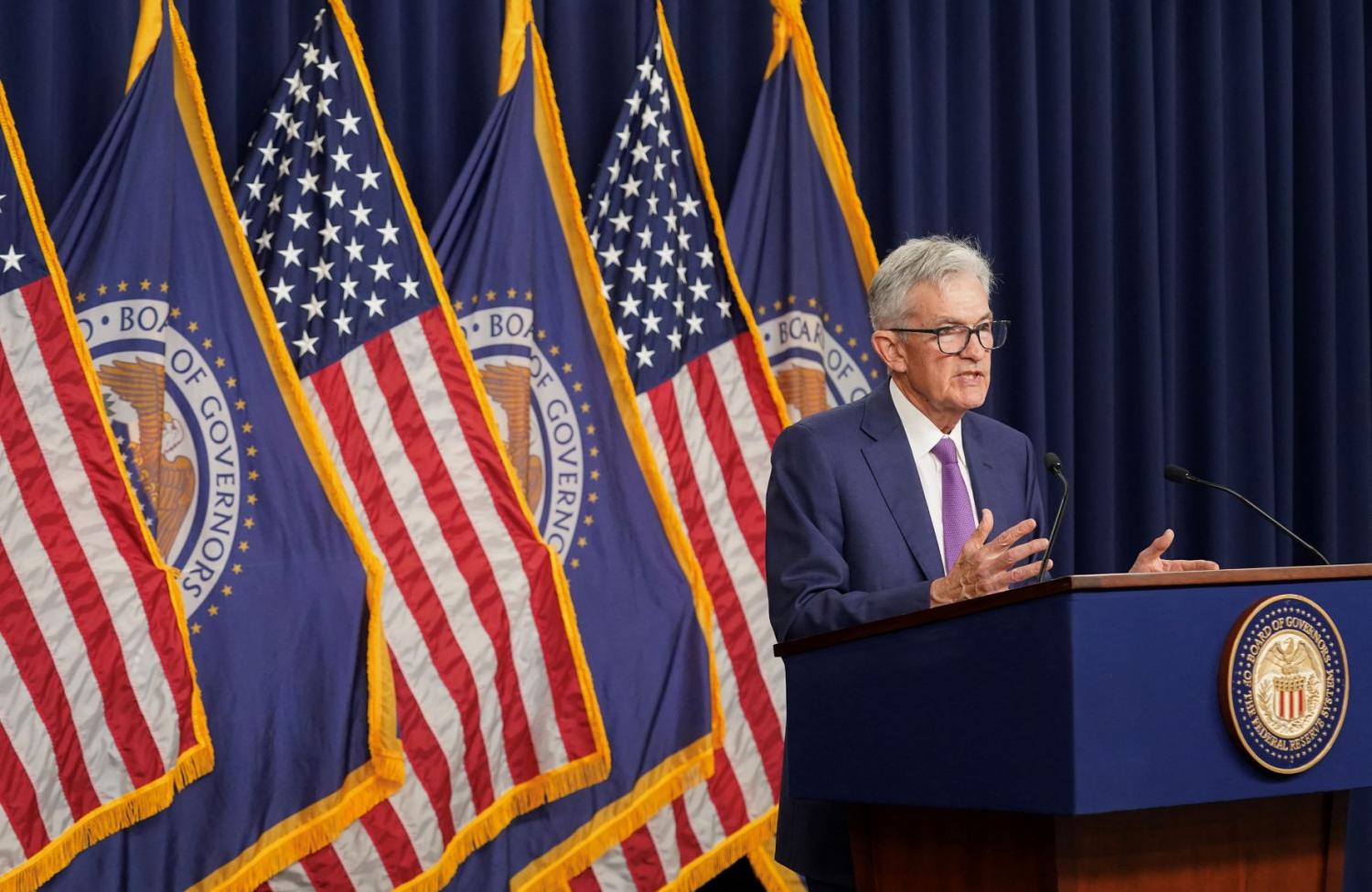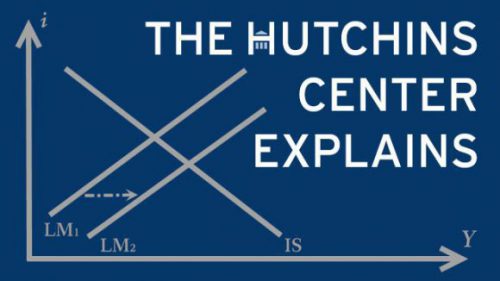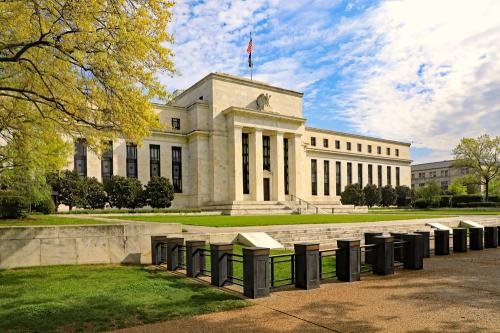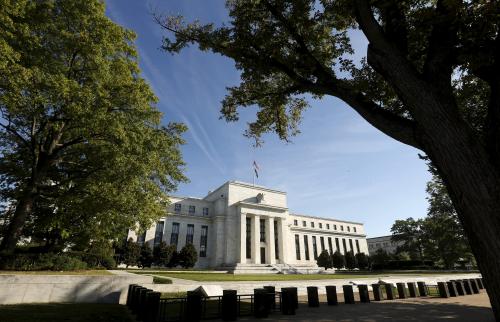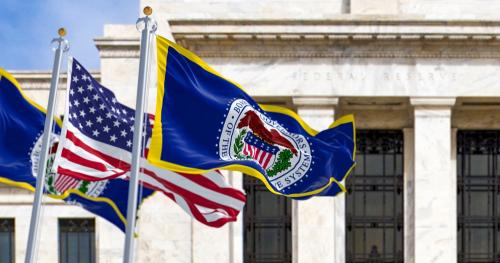Fed watchers in academia and the private sector surveyed by the Hutchins Center on Fiscal & Monetary policy generally give the Federal Reserve high marks for its current communications. Some 81% of academics surveyed give the Fed an A, A-, or B+, and 54% of private sector Fed watchers do the same.
“In the past couple decades, the Fed and other major central banks have come to see communications—with the public and with the markets—as key to effective monetary policy,” said David Wessel, director of the Hutchins Center. “Our survey finds that a broad set of Fed watchers think that Jay Powell’s Fed is doing a pretty good job at communicating its objectives and its views of the economy. Fed watchers in academia and think tanks generally give the Fed higher marks than those on Wall Street or elsewhere in the private sector.”
The 2024 grades are roughly the same as those in the survey we did in 2020 and generally higher than in a survey we did in 2016 when Janet Yellen was Fed chair.
Other highlights of the survey include:
- Respondents find the press conference that Powell holds after each meeting of the Fed’s policy committee to be the single most useful channel of Fed communication.
- Slightly more than half the respondents say the Fed should keep the dot plot—which gives each Fed policymaker’s projections for interest rates—and slightly more than a quarter say the Fed should kill it.
- As in past surveys, most respondents say presidents of the regional Federal Reserve banks should talk less in public.
- The bulk of Fed watchers say they oppose raising the Fed’s 2% inflation target. A plurality of private sector Fed watchers favor replacing the point target with a range (46% vs. 38% opposed and 17% undecided), but a strong majority of academic respondents oppose that change (69% to 25%).
Looking ahead to the Fed’s planned review of its Statement on Longer-Run Goals and Monetary Policy later this year, we also asked respondents for their views on changes to that framework summary. There is little consensus on what changes the Fed watchers recommend.
In all, 56 individuals—32 from academia or think tanks and 24 from the private sector—responded to the survey, which was conducted between March 22 and April 5, 2024.
Download the full findings here
Grading Federal Reserve communications
Asked, “What overall grade would you give current Fed communications?” 55% of Fed watchers in academia and think tanks award an A or A- grade, but only 12% of those on Wall Street or other private firms do—that group is much more likely to give the Fed a B+ (42%) or a B (33%). Of the 55 respondents to the survey, only four (8%) give Fed communications a C or D. (Hover over the charts to see specific data points.)
The median grade given by academics and private sector Fed watchers in 2024 is the same as in the 2020 survey, both of which were conducted while Jay Powell was Fed chair. These median grades are higher than in the 2016 survey, conducted during Janet Yellen’s tenure as Fed chair.
Which channels of communication do Fed watchers find most useful?
Fed watchers find the Fed chair’s press conference, held after each meeting of its policymaking Federal Open Market Committee, the single most useful channel of Fed communication. The quarterly Summary of Economic Projections (excluding the “dot plot,” which gives each FOMC member’s interest rate projections) is a close second, and is followed by the statement issued after each FOMC meeting, and speeches by the Fed chair. These results are similar to those in our 2020 survey.
Slightly more than half of the respondents (58%) rate the dot plot “extremely useful” or “useful,” and nearly one in five (18%) deem it “not useful” or “useless.” Slightly more than half the Fed watchers (55%) say the Fed should keep the dot plot, and slightly more than a quarter (27%) say the Fed should kill it. Several respondents offer suggestions for tweaking the dot plot, including linking FOMC members economic forecasts to their interest rate projections. (More of the respondents’ comments are posted in the full report.)
As in past surveys, most respondents (59%) say presidents of the regional Federal Reserve banks should speak less in public. The bulk of the Fed watchers (61%) say Powell speaks about the right amount. Half (52%) say the same about other members of the Federal Reserve Board, although 39% say they should speak less frequently.
How well does the Fed explain itself?
Asked, “How well do Fed officials explain their economic views and monetary policy plans?” 69% of academic Fed watchers and 46% of private sector Fed watchers say the Fed does “an excellent job” or “does well most of the time.”
We also asked, “How well do you understand the Fed’s reaction function?” To that, a strong majority of respondents—66% of academic or think tank Fed watchers and 58% of those in the private sector—say they are “very clear” or “mostly clear” on it. But about a third of both groups say they have only “a vague understanding of it” or “understand it sometimes, but not all the time.”
Fewer respondents in 2024 say they understand the Fed’s reaction function than we found in our 2020 survey. Back then, 83% of academic Fed watchers and 80% of private sector Fed watchers said they are “very clear” or “mostly clear” on it.
Assessing the Fed’s long-run strategy and communications framework
The Fed first published its Statement on Longer-Run Goals and Monetary Policy in 2012, making public for the first time its 2% inflation target. After years of below-target inflation and short-term interest rates at zero, the Fed unveiled a revised strategy in August 2020 and promised to review it every five years. The review, which the Fed says will begin at the end of this year, comes after a period of higher inflation. We asked respondents about changes to the framework that they recommend. The Fed’s current Statement on Longer-Run Goals and Monetary Policy can be found here.
Should the Fed change its 2% inflation target?
The bulk of respondents—69% of academic and 63% of private sector Fed watchers—say the Fed should not change the inflation target. Among the minority who favor a higher target, the proposals range from 2.5% to 4%. (A couple of respondents favor a decrease.)
One alternative to a fixed inflation target is to adopt a range—the Reserve Bank of Australia, for instance, has an inflation target of between 2% and 3%—to give the Fed more flexibility in achieving its dual mandate of price stability and maximum employment, acknowledge the uncertainties around inflation measures, and avoid excessive attention on hitting a precise number. A substantial majority of academic and think tank Fed watchers favor keeping a point target (69% to 25%), but private sector Fed watchers prefer a range (46% to 38%). Among those who favor a range, the most common recommendation is for the Fed to set an inflation target range of 1.5% to 2.5%.
Should the Fed change the wording of two key sentences in the framework statement?
“Shortfalls of employment”
The current Fed framework says: “The Committee’s policy decisions must be informed by assessments of the shortfalls of employment from its maximum level, recognizing that such assessments are necessarily uncertain and subject to revision.” This passage has been widely interpreted as a signal that the Fed will act more aggressively when unemployment is high than when it is low, an asymmetry that has drawn criticism from Fed watchers who fear it will make monetary policy too prone to above-target inflation. A strong majority of academic Fed watchers (75%) would retain this sentence as written, but a strong majority of those in the private sector (60%) would “substantially revise” or “tweak” it.
“When inflation has been running persistently below 2%”
The current framework says the Fed will seek “inflation that averages 2% over time,” but that “following periods when inflation has been running persistently below 2%, appropriate monetary policy will likely aim to achieve inflation moderately above 2% for some time.” This approach, known as “flexible average inflation targeting,” was conceived when inflation was running persistently below 2%, which, of course, is not the current situation.
Among both sets of Fed watchers, 40% call for leaving the statement unchanged, 31% want it tweaked, and 29% want it revised substantially. The main objection among those who would change the sentence is the asymmetric approach to achieving the inflation target. Ken Kuttner of Williams College called the passage “confusing and contradictory.” noting that “[i]f [the Fed] only makes up for ‘undershoots’ but doesn’t respond symmetrically to ‘overshoots,’ inflation will exceed 2% on average.” Jonathan Wright of Johns Hopkins University said the asymmetry is “hard to defend” and that aiming for above-target inflation should be restricted to periods at which interest rates have fallen to zero. Steven Kamin of the American Enterprise Institute, echoing a recommendation made by others, said that the Fed should abandon the approach and “[r]emove reference to making up for below-target inflation by running above-target inflation,” and stick to trying to achieve its target.
Should the statement say more about quantitative easing and forward guidance?
Quantitative easing (QE) (the purchase of long-term bonds by the Fed to lower long-term interest rates) and forward guidance (central bank communication about the likely path of short-term interest rates) have been important tools of monetary policymaking, but the current Fed long-run strategy statement does not mention them. Both sets of Fed watchers—academics (81%) and private sector (65%)—strongly recommend that the Fed explain how and when it expects to use QE and forward guidance.
What are the most important changes the Fed should make to its strategy statement?
We also asked respondents, in an open-ended question, to identify the most important change the Fed should make in the framework statement. The answers center on the following five themes.
Theme 1: Carefully reconsider the approach to inflation targeting.
“Abandon the AIT of FAIT and keep the F to make it FIT.” –Seamus Brown, Moore Capital
“Remove reference to making up for below-target inflation by running above-target inflation.” –Steven Kamin, American Enterprise Institute
“Remove a willingness to tolerate above 2% inflation even after a period of below-target price pressures.” –Lindsey Piegza, Ph.D., Stifel
“Unwinding the framework changes made in 2020/2021.” –Stephen Stanley, Santander US Capital Markets
Theme 2: Build a more flexible and adaptable framework.
“Re-focusing the statement on achieving 2% inflation on average in the longer run by means of stabilizing inflation expectations—and then setting out the different ways this can be done when policy is unconstrained by the lower bound and when it is constrained by the lower bound.” –Krishna Guha, Evercore ISI
“Since conditions change, sometimes much more rapidly or substantially than expected, the Fed always needs to leave room for a change in policy direction or magnitude. That limits their ability to take strong stands and makes it largely impossible to provide clear guidance. Thus, it really doesn’t matter what the Fed says. Wall Street economists will race to be the first to claim that something will happen, the press will play that up, and when they are wrong, as usual, move on to the next forecast. This is all a game, and the Fed does as well as it can in playing it.” –Joel Naroff, Naroff Economics LLC
“The most helpful step they could take in this framework review is to explain why they didn’t avail themselves of the ‘escape clauses’ they so clearly provided themselves, and that would have allowed them to break from the main thrust of the precommitments they made in Sept. 2020.” –David Wilcox, Bloomberg Economics and the Peterson Institute for International Economics
Theme 3: Be clearer about the reaction function.
“Forward guidance about QE is useful, but not forward guidance about forward guidance. Biggest change: Use some ranges of numbers instead of just words.” –Jonathan A. Parker, MIT
“Be clearer about the monetary policy rule.” –John B. Taylor, Stanford University
Theme 4: Emphasize economic uncertainty to a greater extent in communications.
“Recognize the stochastic nature of the economy and inflation and avoid having the forecasts be the long-run goals of policy. We know these almost never turn out to be the actuality. That is, the 2% inflation forecast in the SEP isn’t a forecast… it’s a goal. The economy is not precise, so ranges are better.” –Allen Sinai, Decision Economics, Inc.
Theme 5: Discuss the role of QE in the formation of policy.
“Aside from raising the target, the most important change would be to integrate QE into the overall policy stance and communicate about both fed funds and QE as tools to achieve the mandate.” –Joseph Gagnon, Peterson Institute for International Economics
“Just note that LSAPs [large-scale asset purchases] (much better term than QE) are in the tool kit when the lower bound is reached and unemployment rate is high and inflation low.” –Charles Steindel, NABE Business Economics
-
Acknowledgements and disclosures
The Brookings Institution is financed through the support of a diverse array of foundations, corporations, governments, individuals, as well as an endowment. A list of donors can be found in our annual reports published online here. The findings, interpretations, and conclusions in this report are solely those of its author(s) and are not influenced by any donation.
The Brookings Institution is committed to quality, independence, and impact.
We are supported by a diverse array of funders. In line with our values and policies, each Brookings publication represents the sole views of its author(s).


